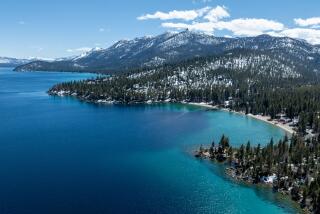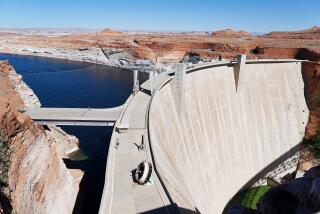Hope Rises in Arizona Flood Area
WELLTON, Ariz. â Farmers and others who live and work along the flooding Gila River got hopeful news Sunday, as authorities vastly scaled back their estimates of how much water will spill over a dam and into the swollen river.
Water has been surging over the Painted Rock Damâs spillway for nine days, flooding thousands of acres of crops, washing out seven bridges and prompting the Arizona National Guard and Yuma County sheriff to urge 5,200 residents along a 90-mile stretch of the Gila River to leave, lest they be marooned in flooded homes.
Residents had been bracing for an even bigger deluge from the dam, but the Army Corps of Engineers said Sunday that the daily spill will probably not get much bigger.
âBecause of this new figure, we hope things are not going to be as bad as we feared,â said Bart Freeman, a coordinator with the Arizona Emergency Management Department.
âBut if El Nino kicks up again, and we get significant rainfall in the mountains or central Arizona, it could be different. Weâre not ready to relax.â
In what has become the regionâs worst flooding since 1927, water has been spilling over the dam at the rate of 20,000 to 24,000 cubic feet per second, more than twice the amount the Gila River channel and its bridges were built to withstand. The corps had been warning that the spillover would reach 45,000 cubic feet per second this weekend, but reduced that figure to a peak of 27,500. A cubic foot of water is 7.4 gallons.
As of Sunday, about 2,000 residents had evacuated. Thousands of acres of lettuce, alfalfa, hay and other crops were either picked hastily and prematurely or inundated; farmers scrapped plans to begin planting wheat.
âBasically the farming system has been shut down--65,000 acres has been shut down until the river stabilizes,â said Doug Cahan, a pest control adviser for Fertizona Co., as he and others stood atop a small mesa and surveyed the flooded fields of Roll, five miles east of Wellton.
Rob Vaughan, an employee of Cactus Seed Co., remembered bitterly how environmentalists fought plans to build the 34-year-old Painted Rock Dam and channel the Gila River.
Environmentalistsâ concern over the effects of channeling water, and the possible destruction of the nesting ground of the endangered clapper rail led the Corps of Engineers to build a smaller dam and a shallower channel than farmers had wanted.
âThis channel was never built to withstand whatâs happening now,â said Clyde Gould, manager of the Wellton-Mohawk Irrigation and Drainage District.
âI wish all those people who worried about that bird could see all this flooding and all these jobs lost,â Vaughan said. âHell, Iâll bet they donât even live here in the Mohawk Valley. I believe in birds, but I believe in people too.â
But Linda Michael of the Sierra Clubâs conservation committee in Southern California is knowledgeable about the Gila River case, and says the flooding is an example of how dams and channels can increase flood damage by giving people a false sense of security.
âBefore dams and channels, people used to have sense enough not to build or plant in flood plains,â she said. Channels make water go faster and straighter than it would in a natural river, exacerbating the risk of damage, Michael added.
The Painted Rock Dam provides flood control for central Arizona, New Mexico and parts of Mexico. Its reservoir is at 113% of capacity and water is expected to overflow for several more weeks.
As they stood watching a bulldozer cut a channel to divert the river from a soaked alfalfa field, Cahan and Vaughan found some things to be thankful for.
The irrigation districtâs main pump has been saved, meaning water in the dry season. And less flooding is now predicted.
âI guess we can live with 27,500,â Vaughan said. âWeâll have to.â
More to Read
Sign up for Essential California
The most important California stories and recommendations in your inbox every morning.
You may occasionally receive promotional content from the Los Angeles Times.










